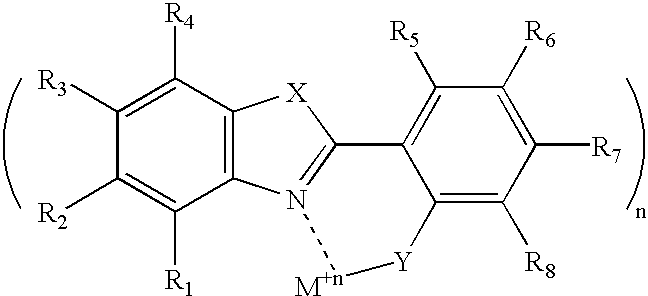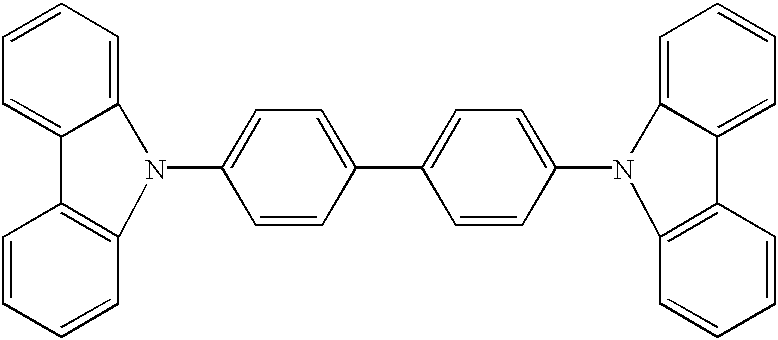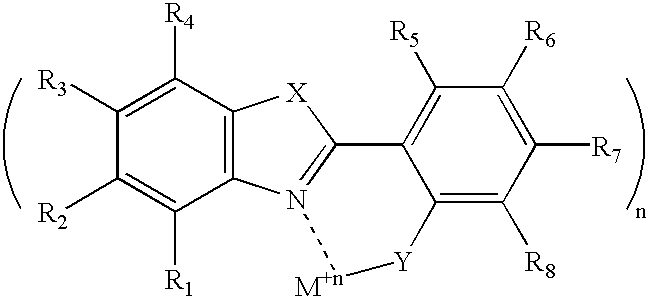Emissive materials for organic light emitting devices
- Summary
- Abstract
- Description
- Claims
- Application Information
AI Technical Summary
Benefits of technology
Problems solved by technology
Method used
Image
Examples
example 1
V.B.2. Example 1
The results for Example 1 were obtained using device 1, wherein device 1 has the following composition.
Device 1: ITO(120 nm) / TPD(50 nm) / Zn(BOX).sub.2 (specifically the molecule of formula 1, below)2.8%-CBP(20 nm) / BCP(10 nm) / Alq3(20 nm) / MgAg(150 nm) / Ag(50 nm) wherein
ITO is a transparent conducting phase of indium tin oxide which functions as an anode.
ITO is a degenerate semiconductor formed by doping a wide band semiconductor. The carrier concentration of the ITO is in excess of 10.sup.19 / cm.sup.3. The number 120 nm (=1200 .ANG.) is the thickness of the ITO layer.
TPD: hole transport layer (HTL) of thickness 50 nm.
Zn(BOX)2(guest)-CBP(host): emitter layer (EML) of thickness 10 nm.
BCP is an exciton blocking and electron transport layer of thickness 10 nm.
Alq3: electron injection layer of thickness 20 nm.
MgAg(thickness 150 nm) / Ag (thickness 50 nm) functions as a cathode TPD, the hole transport layer, has the following formula. ##STR18##
The organometallic dopant Zn(BOX).s...
example 2
V.B.3. Example 2
Results for Example 2 were obtained from device 2, of the following configuration.
Device 2: ITO(120 nm) / TPD(50 nm) / Zn(BOX).sub.2 (as depicted in formula 1) 2 2.8%-TPD(20 nm) / BCP(10 nm) / Alq3(20 nm) / MgAg(150 nm) / Ag(50 nm) wherein
ITO functions as an anode and has thickness 120 nm.
TPD: hole transport layer (HTL), of thickness 50 nm.
Zn(BOX).sub.2 (guest)-TPD(host): emitter layer (EML), of thickness 20 nm.
BCP: exciton blocking and electron transport layer, of thickness 10 nm
Alq3: electron injection layer, of thickness 20 nm
and MgAg(thickness 150 nm) / Ag(thickness50 nm) as a cathode electrode.
The chemical names are used as in Example 1.
The results for Example 2 / device 2 are given in FIGS. 5 through 8.
V. C. Other Molecular Depictions
A molecule for the hole-transporting layer of the invention is depicted below. ##STR24##
The invention will work with other hole-transporting molecules known by one of ordinary skill to work in hole transporting layers of OLEDs.
The molecule which u...
PUM
| Property | Measurement | Unit |
|---|---|---|
| Efficiency | aaaaa | aaaaa |
| Fluorescence | aaaaa | aaaaa |
| Phosphorescence quantum yield | aaaaa | aaaaa |
Abstract
Description
Claims
Application Information
 Login to View More
Login to View More - R&D
- Intellectual Property
- Life Sciences
- Materials
- Tech Scout
- Unparalleled Data Quality
- Higher Quality Content
- 60% Fewer Hallucinations
Browse by: Latest US Patents, China's latest patents, Technical Efficacy Thesaurus, Application Domain, Technology Topic, Popular Technical Reports.
© 2025 PatSnap. All rights reserved.Legal|Privacy policy|Modern Slavery Act Transparency Statement|Sitemap|About US| Contact US: help@patsnap.com



